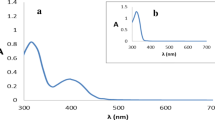Abstract
Trace Cu2+ was detected with high selectivity using specific complexation with bathocuproinesulfonate (BCS) through flow-injection electrospray ionization mass spectrometry (FI-ESI-MS), which separates Cu2+ from coexisting metal ions by forming a Cu–BCS complex with a high mass number. Here, only [CuI(BCS)2]3− was obtained with a high ion count. Its calibration curve was linear from 1.0 × 10−8 to 1.0 × 10−5 M. This method was applied to determine the Cu-complexing capacities of humic acid solution and river water samples by adding traces of Cu2+.
Similar content being viewed by others
References
K. Kumazawa, M. Yoshizawa, H.-B. Liu, Y. Kamikawa, M. Moriyama, T. Kato, and M. Fujita, Chem. Eur. J., 2005, 11, 2519.
H. Hotta, T. Mori, A. Takahashi, Y. Kogure, K. Johno, T. Umemura, and K. Tsunoda, Anal. Chem., 2009, 81, 6357.
S. Boija, A. Almesaker, E. Hedenström, D. Bylund, H. Edlund, and M. Norgren, J. Mass Spectrom., 2014, 49, 550.
K. Minakata, I. Yamagishi, H. Nozawa, K. Gonmori, K. Hasegawa, M. Suzuki, F. Horio, K. Watanabe, and O. Suzuki, Forensic Toxicol., 2012, 30, 149.
D. A. Barnett, R. Handy, and G. Horlick, “Elemental Speciation – New Approaches for Trace Element Analysis”, ed. J. A. Caruso, K. L. Sutton, and K. L. Ackley, 2000, Chap. 12, Elsevier, Amsterdam, 384.
P. G. C. Campbell, “Interaction between trace metal and organisms; critique of the free-ion activity model”, ed. A. Tessier and D. R. Turner, 1995, J. Wiley & Sons, New York, 45.
H. Itabashi, Y. Kamata, D. Kawaguchi, and H. Kawamoto, Anal. Sci., 2003, 19, 1277.
E. Y. Jeong, M. B. Ansari, Y. H. Mo, and S. E. Park, J. Hazard. Mater., 2011, 185, 1311.
D. W. Dixon, A. F. Gill, and B. R. Sook, J. Porphyrins Phthalocyanines, 2004, 8, 1300.
B. Zak, J. S. Cohen, and L. A. Williams, Microchem. J., 1962, 6, 67.
T. Imamura and M. Fujimoto, Bull. Chem. Soc. Jpn., 1975, 48, 2971.
Author information
Authors and Affiliations
Corresponding author
Electronic supplementary material
Rights and permissions
About this article
Cite this article
Mori, M., Misawa, K. & Itabashi, H. Highly Selective Detection of Trace Copper(II) Using Bathocuproinesulfonate by Flow-Injection Electrospray Ionization Mass Spectrometry. ANAL. SCI. 30, 1173–1176 (2014). https://doi.org/10.2116/analsci.30.1173
Received:
Accepted:
Published:
Issue Date:
DOI: https://doi.org/10.2116/analsci.30.1173




